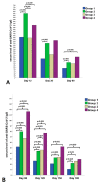Fever after Vaccination against SARS-CoV-2 with mRNA-Based Vaccine Associated with Higher Antibody Levels during 6 Months Follow-Up
- PMID: 35335080
- PMCID: PMC8950492
- DOI: 10.3390/vaccines10030447
Fever after Vaccination against SARS-CoV-2 with mRNA-Based Vaccine Associated with Higher Antibody Levels during 6 Months Follow-Up
Abstract
Background: The effect of post-vaccination adverse events on immunogenicity is unknown. We aimed to explore relationship between post-vaccination adverse reactions and antibody levels during 6-month follow-up.
Methods: Blood was serially drawn from healthcare workers after the second dose of BNT162b2 mRNA vaccine (Day 12, 30, 60, 90, 120, 150, and 180) and anti-SARS-CoV-2 spike IgG (S-IgG) levels were measured. Following each vaccine dose, volunteers completed a questionnaire regarding adverse reactions (symptomatic vs. asymptomatic groups).
Results: A total of 395 subjects received the second dose of the vaccine. The main results were as follows: (i) fever after the 2nd dose was independently associated with the median S-IgG level at all follow-up time points; (ii) significantly higher S-IgG levels were observed in the symptomatic group of patients without prior COVID-19 infection throughout the entire follow-up period; (iii) prior COVID-19 positivity resulted in higher S-IgG levels only in the asymptomatic group from Day 90 of the follow-up period; (iv) both prior COVID-19 disease with asymptomatic status and symptomatic status without prior COVID-19 infection resulted in similar S-IgG antibody levels; (v) significantly lower serum S-IgG levels were observed in smokers.
Conclusion: Fever may play an important role in the post-vaccination immune response in the long term.
Keywords: COVID-19; adverse reaction; anti-SARS-CoV-2; fever; mRNA vaccine; spike IgG.
Conflict of interest statement
The authors declare no conflict of interest.
Figures



Similar articles
-
Healthcare Workers in South Korea Maintain a SARS-CoV-2 Antibody Response Six Months After Receiving a Second Dose of the BNT162b2 mRNA Vaccine.Front Immunol. 2022 Jan 31;13:827306. doi: 10.3389/fimmu.2022.827306. eCollection 2022. Front Immunol. 2022. PMID: 35173736 Free PMC article.
-
Immunogenicity of the BNT162b2 COVID-19 mRNA vaccine and early clinical outcomes in patients with haematological malignancies in Lithuania: a national prospective cohort study.Lancet Haematol. 2021 Aug;8(8):e583-e592. doi: 10.1016/S2352-3026(21)00169-1. Epub 2021 Jul 2. Lancet Haematol. 2021. PMID: 34224668 Free PMC article.
-
Impact of prior infection status on antibody response to the BNT162b2 mRNA COVID-19 vaccine in healthcare workers at a COVID-19 referral hospital in Milan, Italy.Hum Vaccin Immunother. 2021 Dec 2;17(12):4747-4754. doi: 10.1080/21645515.2021.2002639. Epub 2022 Jan 27. Hum Vaccin Immunother. 2021. PMID: 35086438 Free PMC article.
-
Differences in IgG Antibody Responses following BNT162b2 and mRNA-1273 SARS-CoV-2 Vaccines.Microbiol Spectr. 2021 Dec 22;9(3):e0116221. doi: 10.1128/Spectrum.01162-21. Epub 2021 Nov 10. Microbiol Spectr. 2021. PMID: 34756093 Free PMC article.
-
Evaluation of the SARS-CoV-2 Antibody Response to the BNT162b2 Vaccine in Patients Undergoing Hemodialysis.JAMA Netw Open. 2021 Sep 1;4(9):e2123622. doi: 10.1001/jamanetworkopen.2021.23622. JAMA Netw Open. 2021. PMID: 34473256 Free PMC article.
Cited by
-
Development of a personalized digital biomarker of vaccine-associated reactogenicity using wearable sensors and digital twin technology.Commun Med (Lond). 2025 Apr 13;5(1):115. doi: 10.1038/s43856-025-00840-8. Commun Med (Lond). 2025. PMID: 40223099 Free PMC article.
-
Adverse Reactions after Booster SARS-CoV-2 Vaccination Have Less Impact on Antibody Response than after Basic Vaccination Scheme.Vaccines (Basel). 2023 Jan 15;11(1):182. doi: 10.3390/vaccines11010182. Vaccines (Basel). 2023. PMID: 36680026 Free PMC article.
-
Modeling and predicting individual variation in COVID-19 vaccine-elicited antibody response in the general population.PLOS Digit Health. 2024 May 3;3(5):e0000497. doi: 10.1371/journal.pdig.0000497. eCollection 2024 May. PLOS Digit Health. 2024. PMID: 38701055 Free PMC article.
-
Risk of Repeated Adverse Effects following Booster Dose of mRNA COVID-19 Vaccine: Results from the MOSAICO Study.Vaccines (Basel). 2023 Jan 22;11(2):247. doi: 10.3390/vaccines11020247. Vaccines (Basel). 2023. PMID: 36851125 Free PMC article.
-
COVID-19 Vaccination Trends and Side Effects among Egyptian Hemodialysis Patients: A Multicenter Survey Study.Vaccines (Basel). 2022 Oct 21;10(10):1771. doi: 10.3390/vaccines10101771. Vaccines (Basel). 2022. PMID: 36298635 Free PMC article.
References
-
- [(accessed on 29 January 2022)]. Available online: https://www.who.int/emergencies/diseases/novel-coronavirus-2019.
-
- [(accessed on 25 January 2022)]. Available online: https://ourworldindata.org/COVID-vaccinations.
LinkOut - more resources
Full Text Sources
Miscellaneous

